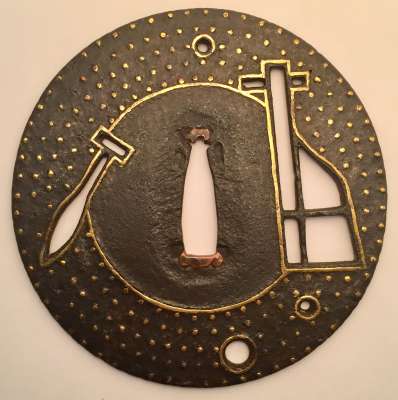-
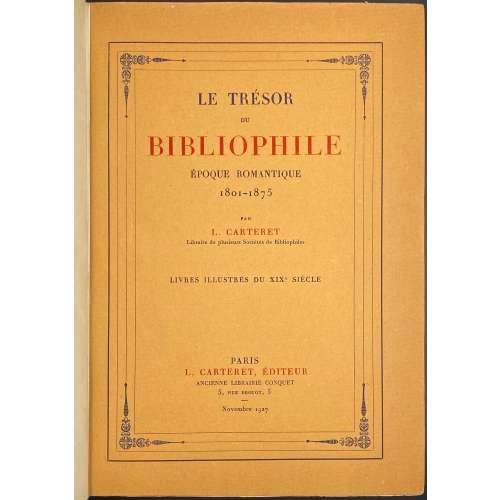 Description: One volume, collated 4to, 26.2 x 18.5 x 8 cm, ¾ calf over marbled boards, gilt decorated flat spine with gilt lettering, marbled endpapers, publisher’s wrappers preserved. Title-page (red and black): LE TRÉSOR | DU | BIBLIOPHILE | ÉPOQUE ROMANTIQUE | 1801–1875 | PAR | L. CARTERET | Libraire de plusieurs Sociétés de Bibliophiles | LIVRES ILLUSTRÉS DU XIXe SIÈCLE | PARIS | L. CARTERET, ÉDITEUR | ANCIENNE LIBRAIRIE CONQUET | 5, RUE DROUOT, 5 | Novembre 1927 || Publisher's wrapper similar, in a frame Collation: front wrapper, π4 (2 blanks, h.t./limit., t.p./copyright], [1] – 894, χ2 (colophon, 1 blank), back wrapper, orig. spine, ils. within collation; total 362 leaves within wrappers; 2 leaves of modern inset bound-in between pp. 106 and 107. Pagination: [8][1-3] 4-712 [4], total 724 pages plus 4 pp inset, ils. Content: pp. 1-25 – propos; 29-600 – bibliographie; 601-603 – table ills; 605-639 – table des ouvrages cités; 641-712 – table des artistes. Printed by Imp. Lahure on November 30, 1927. Contributors: Léopold Carteret (French, 1873 – 1948) Imprimerie Générale de A. Lahure (Paris) Alexis Lahure (French, 1849 – 1928)
Description: One volume, collated 4to, 26.2 x 18.5 x 8 cm, ¾ calf over marbled boards, gilt decorated flat spine with gilt lettering, marbled endpapers, publisher’s wrappers preserved. Title-page (red and black): LE TRÉSOR | DU | BIBLIOPHILE | ÉPOQUE ROMANTIQUE | 1801–1875 | PAR | L. CARTERET | Libraire de plusieurs Sociétés de Bibliophiles | LIVRES ILLUSTRÉS DU XIXe SIÈCLE | PARIS | L. CARTERET, ÉDITEUR | ANCIENNE LIBRAIRIE CONQUET | 5, RUE DROUOT, 5 | Novembre 1927 || Publisher's wrapper similar, in a frame Collation: front wrapper, π4 (2 blanks, h.t./limit., t.p./copyright], [1] – 894, χ2 (colophon, 1 blank), back wrapper, orig. spine, ils. within collation; total 362 leaves within wrappers; 2 leaves of modern inset bound-in between pp. 106 and 107. Pagination: [8][1-3] 4-712 [4], total 724 pages plus 4 pp inset, ils. Content: pp. 1-25 – propos; 29-600 – bibliographie; 601-603 – table ills; 605-639 – table des ouvrages cités; 641-712 – table des artistes. Printed by Imp. Lahure on November 30, 1927. Contributors: Léopold Carteret (French, 1873 – 1948) Imprimerie Générale de A. Lahure (Paris) Alexis Lahure (French, 1849 – 1928) -
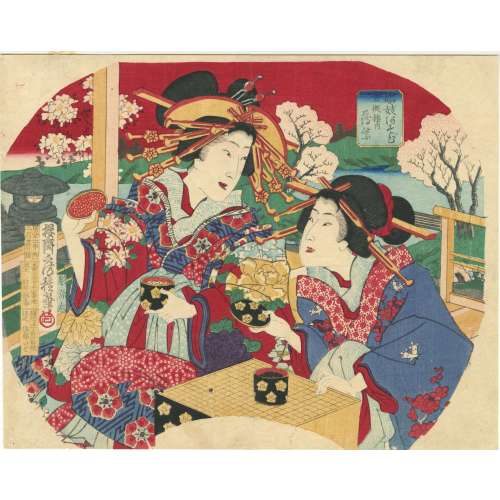 Artist: Utagawa Fusatane [歌川 房種] (Japanese, fl. 1854 – 1889), other names: Ippyosai; Isshosai; Murai Seima; Utagawa Seimas; Osai; Signed: Ōsai Fusatane Hitsu [桜斎房種筆] in a cartouche, with a round stamp. Block carver: Watanabe Yatarō (Japanese, 1850 – 1913); seal [彫弥太] – Hori Yata (Friese 2009b: 117). Publisher [板元] (Hammoto): Satō Ise [佐藤いせ], address: Horiechō, Nichōme, ichi-banchi [堀江町二丁目一番地] Publication date [御届] (otodoke): Meiji 10th year, 3rd month, 22nd day (1877). Artist [画工] (Gakō): Murai Seima [村井 静馬], address: Honjo-Sotodechō, 18 [本所外手丁十八番地]. Uncut fan print (uchiwa-e), 236 x 297 mm, depicting two harlots or courtesans playing [娼妓あそび] (shōgi asobi) go game in the famous Kinpeiro [金瓶楼内] brothel in New Yoshiwara in Tokyo. In the courtesan's name, the second character seems to be 紫 (Murasaki); the first character is unclear, so we do not know her name yet.
Artist: Utagawa Fusatane [歌川 房種] (Japanese, fl. 1854 – 1889), other names: Ippyosai; Isshosai; Murai Seima; Utagawa Seimas; Osai; Signed: Ōsai Fusatane Hitsu [桜斎房種筆] in a cartouche, with a round stamp. Block carver: Watanabe Yatarō (Japanese, 1850 – 1913); seal [彫弥太] – Hori Yata (Friese 2009b: 117). Publisher [板元] (Hammoto): Satō Ise [佐藤いせ], address: Horiechō, Nichōme, ichi-banchi [堀江町二丁目一番地] Publication date [御届] (otodoke): Meiji 10th year, 3rd month, 22nd day (1877). Artist [画工] (Gakō): Murai Seima [村井 静馬], address: Honjo-Sotodechō, 18 [本所外手丁十八番地]. Uncut fan print (uchiwa-e), 236 x 297 mm, depicting two harlots or courtesans playing [娼妓あそび] (shōgi asobi) go game in the famous Kinpeiro [金瓶楼内] brothel in New Yoshiwara in Tokyo. In the courtesan's name, the second character seems to be 紫 (Murasaki); the first character is unclear, so we do not know her name yet. -
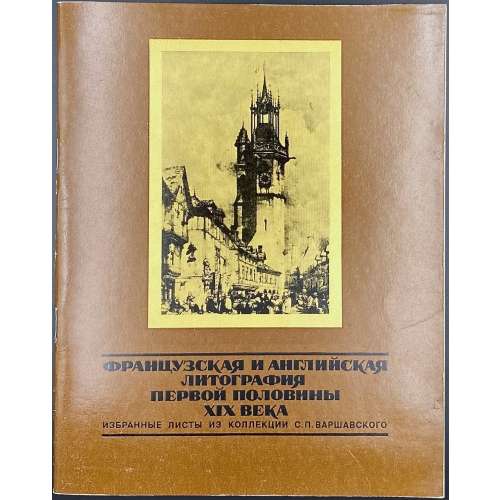 French and English lithography of the first half of the 19th century: Selected sheets from the collection of Sergei Petrovich Varshavsky [Сергей Петрович Варшавский] (Jewish-Russian, 1906 – 1980). New acquisitions at The Pushkin State Museum of Fine Arts (Moscow). Выпущено по заказу ГМИИ им. А. С. Пушкина; вступ. статьи В. А. Мишина и Ю. С. Варшавского; составитель каталога В. А. Мишин. (Produced under order of The Pushkin State Museum of Fine Arts (Moscow); introduction by V. A. Mishin and Yury Varshavsky). Softcover, glossy pictorial wrappers, 21.5 x 17 cm, 25 leaves, not paginated, frontispiece and 7 leaves of plates, 50 entries. Title-page: | — | ФРАНЦУЗСКАЯ И АНГЛИЙСКАЯ | ЛИТОГРАФИЯ | ПЕРВОЙ ПОЛОВИНЫ | XIX ВЕКА | ИЗБРАННЫЕ ЛИСТЫ ИЗ КОЛЛЕКЦИИ С.П. ВАРШАВСКОГО | — | НОВЫЕ ПОСТУПЛЕНИЯ | В ГОСУДАРСТВЕННЫЙ МУЗЕЙ | ИЗОБРАЗИТЕЛЬНЫХ | ИСКУССТВ | ИМЕНИ А. С. ПУШКИНА | {publisher’s device} | Москва | Советский художник | 1985 ||
French and English lithography of the first half of the 19th century: Selected sheets from the collection of Sergei Petrovich Varshavsky [Сергей Петрович Варшавский] (Jewish-Russian, 1906 – 1980). New acquisitions at The Pushkin State Museum of Fine Arts (Moscow). Выпущено по заказу ГМИИ им. А. С. Пушкина; вступ. статьи В. А. Мишина и Ю. С. Варшавского; составитель каталога В. А. Мишин. (Produced under order of The Pushkin State Museum of Fine Arts (Moscow); introduction by V. A. Mishin and Yury Varshavsky). Softcover, glossy pictorial wrappers, 21.5 x 17 cm, 25 leaves, not paginated, frontispiece and 7 leaves of plates, 50 entries. Title-page: | — | ФРАНЦУЗСКАЯ И АНГЛИЙСКАЯ | ЛИТОГРАФИЯ | ПЕРВОЙ ПОЛОВИНЫ | XIX ВЕКА | ИЗБРАННЫЕ ЛИСТЫ ИЗ КОЛЛЕКЦИИ С.П. ВАРШАВСКОГО | — | НОВЫЕ ПОСТУПЛЕНИЯ | В ГОСУДАРСТВЕННЫЙ МУЗЕЙ | ИЗОБРАЗИТЕЛЬНЫХ | ИСКУССТВ | ИМЕНИ А. С. ПУШКИНА | {publisher’s device} | Москва | Советский художник | 1985 || -
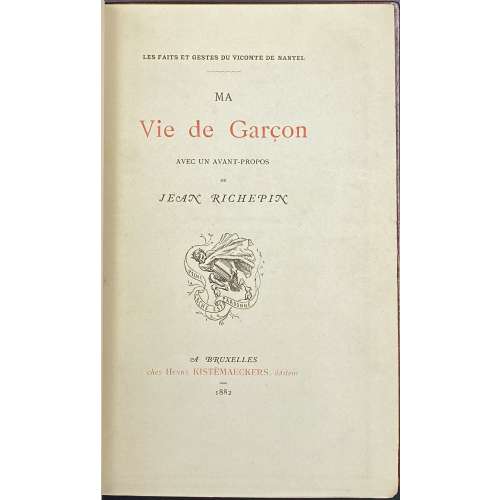 The text attributed to Claude-Prosper Jolyot de Crébillon, dit Crébillon fils (French, 1707 – 1777) or to Anne Claude de Caylus (French, 1692 – 1765). A hardcover volume, 21 x 13.5 cm, collated in-12mo, bound by H. Blanchetière in full crushed brown morocco, spine with raised bands, gilt lettering “VICOMTE | DE NANTEL | – | MA VIE | DE | GARÇON” and “BRUXELLES | 1882” in the bottom compartment; gilt double-fillet to cover margins, six gilt fillets inside, woven silk endpapers, marbled flyleaves, original publisher’s wrappers preserved; the bookplate of Henri Bosc to f.e.p. verso (monogrammed by Martin Van Maële), bookplate of J.-P. Dutel to flyleaf, 18 x 9 cm manuscript list of illustrations tipped in (lettered “12 aquarelles originales | de Martin Van Maële” on top), all margins gilt; printed on tinted paper. Collation: [1] front wrapper lettered in red and black, [1] half-title with limitation to verso, frontispiece by Amédée Lynen, verso inscribed by Van Maële to Bosc, meaning “A jewel for a most sympathetic and sensitive connoisseur Mr H. Bosc”, signed; [1] t.p. in red and black/blank, 06 (pp. [i]-xii) Avant-propos by Jean Richepin, 1-116 (pp. [5]-116) 124 (pp. 117-143, [144] colophon) [1] back wrapper w/advert (Extrait de Gil Blas), spine w/price 10 Fr.; 12 watercolours by Van Maële extraneous to collation, all signed “with his full name in a flowery script”, as per S. A. Perry. Title-page / Cover (red and black): LES FAITS ET GESTES DU VICOMTE DE NANTEL | ~ | MA | Vie de Garçon | AVEC UN AVANT-PROPOS | DE | JEAN RICHEPIN | {publisher’s device} | A BRUXELLES | Chez Henry KISTEMAECKERS, éditeur | – | 1882 || Worldcat : xii, 143 pages frontispiece 20 cm; OCLC Number / Unique Identifier: 5887998. Limitation: 300 copies on papier teinté, 10 copies on papeir du Japon. This is a unique copy enriched with 12 original watercolours by Martin Van Maële. Colophon: ACHEVÉ D’IMPIMER | le 30 mai 1882. | par A. LEFÈVRE, a BRUXELLES | {printer’s device} | POUR | Henry Kistemaeckers, Editeur | à Bruxelles. || Catalogue raisonné: S. A. Perry (2015) № 89 / [LIB-2920.2022] Sheryl A. Perry. Martin van Maële: An illustrated bibliographical checklist. — Las Vegas, 2021. Ref: The Erotica Bibliophile. Contributors: Jean Richepin (French, 1849 – 1926) – author (avant-propos). Maurice François Alfred Martin van Maële [Martin van Maële] (French, 1863 – 1926) – artist. Amédée Ernest Lynen (French, 1852 – 1938) – artist (frontispiece). Henry Kistemaeckers (Belgian, 1851–1934) – publisher. Henri Bosc [Henri Marie Joseph Danviolet] (French, 1884 – 1967) – provenance. J.-P. Dutel description: [Claude-Prosper Jolyot de CRÉBILLON ?]. LES FAITS ET GESTES DU VICOMTE DE NANTEL. MA VIE DE GARÇON. Avec un avant-propos de Jean Richepin. Bruxelles, Henry Kistemaeckers. 1882. In-8 (202 x 120 mm) de XII, 143 pp. et [1] p. Maroquin brun, dos à 5 nerfs, filets dorés sur les coupes et les bordures intérieures, tranches dorées, gardes en moire, double-gardes en papier, couverture et dos conservés. (H. Blanchetière). Le texte est attribué à Claude-Prosper Jolyot de Crébillon, dit Crébillon fils, (1707-1777). Cette édition fut publiée en 1882 à Bruxelles par Kistemaeckers et est ornée d’unfrontispice d’A. Lynen. TIRAGE : 10 ex. sur japon. 500 ex. sur papier teinté. UN DES 500 EXEMPLAIRES SUR PAPIER TEINTÉ ORNÉ DE 12 AQUARELLES ORIGINALES HORSTEXTE SIGNÉES PAR MARTIN VAN MAELE.
The text attributed to Claude-Prosper Jolyot de Crébillon, dit Crébillon fils (French, 1707 – 1777) or to Anne Claude de Caylus (French, 1692 – 1765). A hardcover volume, 21 x 13.5 cm, collated in-12mo, bound by H. Blanchetière in full crushed brown morocco, spine with raised bands, gilt lettering “VICOMTE | DE NANTEL | – | MA VIE | DE | GARÇON” and “BRUXELLES | 1882” in the bottom compartment; gilt double-fillet to cover margins, six gilt fillets inside, woven silk endpapers, marbled flyleaves, original publisher’s wrappers preserved; the bookplate of Henri Bosc to f.e.p. verso (monogrammed by Martin Van Maële), bookplate of J.-P. Dutel to flyleaf, 18 x 9 cm manuscript list of illustrations tipped in (lettered “12 aquarelles originales | de Martin Van Maële” on top), all margins gilt; printed on tinted paper. Collation: [1] front wrapper lettered in red and black, [1] half-title with limitation to verso, frontispiece by Amédée Lynen, verso inscribed by Van Maële to Bosc, meaning “A jewel for a most sympathetic and sensitive connoisseur Mr H. Bosc”, signed; [1] t.p. in red and black/blank, 06 (pp. [i]-xii) Avant-propos by Jean Richepin, 1-116 (pp. [5]-116) 124 (pp. 117-143, [144] colophon) [1] back wrapper w/advert (Extrait de Gil Blas), spine w/price 10 Fr.; 12 watercolours by Van Maële extraneous to collation, all signed “with his full name in a flowery script”, as per S. A. Perry. Title-page / Cover (red and black): LES FAITS ET GESTES DU VICOMTE DE NANTEL | ~ | MA | Vie de Garçon | AVEC UN AVANT-PROPOS | DE | JEAN RICHEPIN | {publisher’s device} | A BRUXELLES | Chez Henry KISTEMAECKERS, éditeur | – | 1882 || Worldcat : xii, 143 pages frontispiece 20 cm; OCLC Number / Unique Identifier: 5887998. Limitation: 300 copies on papier teinté, 10 copies on papeir du Japon. This is a unique copy enriched with 12 original watercolours by Martin Van Maële. Colophon: ACHEVÉ D’IMPIMER | le 30 mai 1882. | par A. LEFÈVRE, a BRUXELLES | {printer’s device} | POUR | Henry Kistemaeckers, Editeur | à Bruxelles. || Catalogue raisonné: S. A. Perry (2015) № 89 / [LIB-2920.2022] Sheryl A. Perry. Martin van Maële: An illustrated bibliographical checklist. — Las Vegas, 2021. Ref: The Erotica Bibliophile. Contributors: Jean Richepin (French, 1849 – 1926) – author (avant-propos). Maurice François Alfred Martin van Maële [Martin van Maële] (French, 1863 – 1926) – artist. Amédée Ernest Lynen (French, 1852 – 1938) – artist (frontispiece). Henry Kistemaeckers (Belgian, 1851–1934) – publisher. Henri Bosc [Henri Marie Joseph Danviolet] (French, 1884 – 1967) – provenance. J.-P. Dutel description: [Claude-Prosper Jolyot de CRÉBILLON ?]. LES FAITS ET GESTES DU VICOMTE DE NANTEL. MA VIE DE GARÇON. Avec un avant-propos de Jean Richepin. Bruxelles, Henry Kistemaeckers. 1882. In-8 (202 x 120 mm) de XII, 143 pp. et [1] p. Maroquin brun, dos à 5 nerfs, filets dorés sur les coupes et les bordures intérieures, tranches dorées, gardes en moire, double-gardes en papier, couverture et dos conservés. (H. Blanchetière). Le texte est attribué à Claude-Prosper Jolyot de Crébillon, dit Crébillon fils, (1707-1777). Cette édition fut publiée en 1882 à Bruxelles par Kistemaeckers et est ornée d’unfrontispice d’A. Lynen. TIRAGE : 10 ex. sur japon. 500 ex. sur papier teinté. UN DES 500 EXEMPLAIRES SUR PAPIER TEINTÉ ORNÉ DE 12 AQUARELLES ORIGINALES HORSTEXTE SIGNÉES PAR MARTIN VAN MAELE. -
 Photographic portrait of poet Joseph Brodsky, head, hand, and shoulder, three-quarters to the left, wearing glasses and with a cigarette. Pencil-signed on the mat: 5/45 • Mikhail Lemkhin; same inscription on the back of the print, and ink stamp ©Mikhail Lemkhin. Sitter: Joseph Brodsky [Иосиф Александрович Бродский ] (Russian-American-Jewish, 1940 – 1996). Size: mat: 41 x 51 cm; window: 27 x 30 cm; print: 27.7 x 35.4 cm.
Photographic portrait of poet Joseph Brodsky, head, hand, and shoulder, three-quarters to the left, wearing glasses and with a cigarette. Pencil-signed on the mat: 5/45 • Mikhail Lemkhin; same inscription on the back of the print, and ink stamp ©Mikhail Lemkhin. Sitter: Joseph Brodsky [Иосиф Александрович Бродский ] (Russian-American-Jewish, 1940 – 1996). Size: mat: 41 x 51 cm; window: 27 x 30 cm; print: 27.7 x 35.4 cm. -
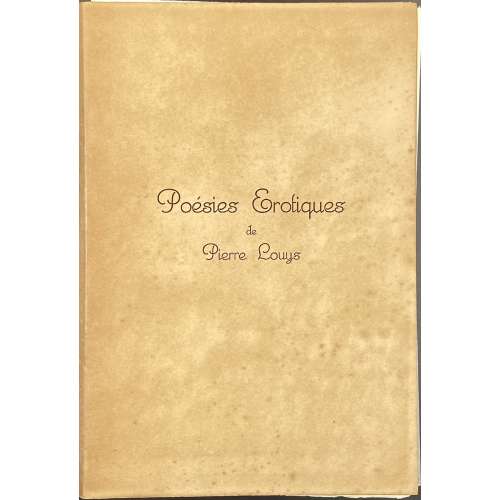 Publisher’s wrappers, 21.3 x 14.8 cm, 10 four-leave gatherings, unsigned, pp.: [8] 1-70 [2]; total 40 leaves (80 pages), illustrated with 73 in-text woodcuts in sanguine after Feodor Rojankovsky drawings. [1]4 recto reproduces the author’s handwriting. Unbound. Some foxing to the wrappers, all pages clean. Title-page: Poésies Érotiques | de | Pierre Louys | {vignette} | ROME | 1937 || Print run limited to 311 copies, 230 copies (№№ 71-300) on BFK Rives wove paper (watermarked); of which this is copy № 93. Catalogue raisonné: Dutel III 2230. Contributors: Pierre Louÿs (French, 1870 – 1925) – author. Feodor Rojankovsky [Rojan, Фёдор Степанович Рожанковский] (Russian-American, 1891 – 1970).
Publisher’s wrappers, 21.3 x 14.8 cm, 10 four-leave gatherings, unsigned, pp.: [8] 1-70 [2]; total 40 leaves (80 pages), illustrated with 73 in-text woodcuts in sanguine after Feodor Rojankovsky drawings. [1]4 recto reproduces the author’s handwriting. Unbound. Some foxing to the wrappers, all pages clean. Title-page: Poésies Érotiques | de | Pierre Louys | {vignette} | ROME | 1937 || Print run limited to 311 copies, 230 copies (№№ 71-300) on BFK Rives wove paper (watermarked); of which this is copy № 93. Catalogue raisonné: Dutel III 2230. Contributors: Pierre Louÿs (French, 1870 – 1925) – author. Feodor Rojankovsky [Rojan, Фёдор Степанович Рожанковский] (Russian-American, 1891 – 1970). -
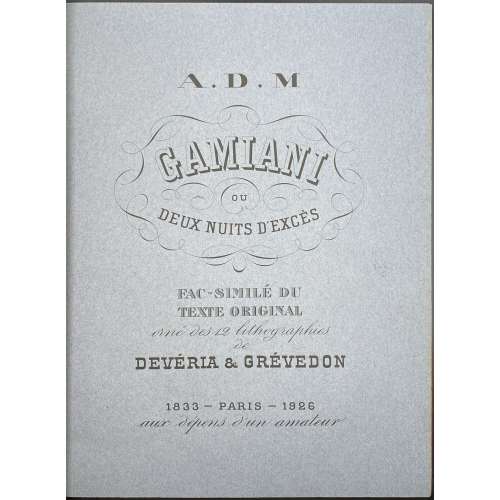 Description: ¾ contemporary red morocco over marbled boards, 33.1 x 25.8 cm, raised bands, gilt lettering to spine, in a marbled slipcase 34.2 x 25.9 cm. Printed on thick wove paper watermarked “MONTGOLFIER ANNONAY” by Canson & Montgolfier (Annonay, France). Front wrapper and title-page : A. D. M. | GAMIANI | OU | DEUX NUITS D’EXCÉS | FAC-SIMILE DU | TEXTE ORIGINAL | orné des 12 lithographies | de | DEVÉRIA & GRÉVEDON | 1833 – Paris – 1926 | aux dépens d'un amateur || Faux-t.p. (1): GAMIANI | OU | UNE NUIT D’EXCÉS | {vignette} | Bruxelles | 1833 || (fac-semilé of the original wrapper of 1833) Faux-t.p. (2): GAMIANI | OU | DEUX NUITS D’EXCÉS | {vignette} | Bruxelles | 1833 || (fac-semilé of the original wrapper of 1833) Collation: 2 blanks, 1 orig. lavender blue colour front wrapper, 1 blank, 1 h.t., 1 limitation p., 1 t.p., 3 leaves ‘Notice Bibliographique’, 32 leaves of printed text, 2 blanks, 1 brown faux t.p. (1), text in fac-semilé manuscript (7 leaves) with 8 coloured plates, 1 blank, 1 brown faux t.p. (2), 7 leaves of text with 4 plates, 2 blanks, brown back wrapper, lavender blue back wrapper, 2 blanks; total 64 leaves plus 16 plates. Pagination: [1-8] 9-75 [76] [4]; [1] 2-26; mispaginated p. 23 marked 25, f.t.p. and ffl not counted. Last four plates without letters. Limitation: a print run of 360 copies, of which 20 with ‘miniatures’ №№ 1-20, 100 with coloured plates №№ 21-120, 230 with b/w plates №№ 121-350; 10 copies not for sale, marked H. C. (hors commerce). This is copy № 201, which should be with black lithographs, but has coloured plates. According to J.-P. Dutel, the plates were printed from the original stones. For variations on Devéria & Grévedon designs for Gamiani see also: LIB-3087.2022 (Bruxelles, 1864); LIB-3093.2022 (Bruxelles, 1866); LIB-3090.2022 (Bruxelles, 1871); LIB-2902.2021 (Greman, 1911); LIB-2903.2021 (late 1940s). Catalogue raisonné: Dutel III 1640, p. 185. Contributors : Alfred de Musset (French, 1810 – 1857) – author. André Warnod [André de Sermanmagny] (French, 1885 – 1960) – author (bibliographical note) Pierre Louis Henri Grévedon (French, 1776 – 1860) – artist. Achille Devéria (French, 1800 – 1857) – artist.
Description: ¾ contemporary red morocco over marbled boards, 33.1 x 25.8 cm, raised bands, gilt lettering to spine, in a marbled slipcase 34.2 x 25.9 cm. Printed on thick wove paper watermarked “MONTGOLFIER ANNONAY” by Canson & Montgolfier (Annonay, France). Front wrapper and title-page : A. D. M. | GAMIANI | OU | DEUX NUITS D’EXCÉS | FAC-SIMILE DU | TEXTE ORIGINAL | orné des 12 lithographies | de | DEVÉRIA & GRÉVEDON | 1833 – Paris – 1926 | aux dépens d'un amateur || Faux-t.p. (1): GAMIANI | OU | UNE NUIT D’EXCÉS | {vignette} | Bruxelles | 1833 || (fac-semilé of the original wrapper of 1833) Faux-t.p. (2): GAMIANI | OU | DEUX NUITS D’EXCÉS | {vignette} | Bruxelles | 1833 || (fac-semilé of the original wrapper of 1833) Collation: 2 blanks, 1 orig. lavender blue colour front wrapper, 1 blank, 1 h.t., 1 limitation p., 1 t.p., 3 leaves ‘Notice Bibliographique’, 32 leaves of printed text, 2 blanks, 1 brown faux t.p. (1), text in fac-semilé manuscript (7 leaves) with 8 coloured plates, 1 blank, 1 brown faux t.p. (2), 7 leaves of text with 4 plates, 2 blanks, brown back wrapper, lavender blue back wrapper, 2 blanks; total 64 leaves plus 16 plates. Pagination: [1-8] 9-75 [76] [4]; [1] 2-26; mispaginated p. 23 marked 25, f.t.p. and ffl not counted. Last four plates without letters. Limitation: a print run of 360 copies, of which 20 with ‘miniatures’ №№ 1-20, 100 with coloured plates №№ 21-120, 230 with b/w plates №№ 121-350; 10 copies not for sale, marked H. C. (hors commerce). This is copy № 201, which should be with black lithographs, but has coloured plates. According to J.-P. Dutel, the plates were printed from the original stones. For variations on Devéria & Grévedon designs for Gamiani see also: LIB-3087.2022 (Bruxelles, 1864); LIB-3093.2022 (Bruxelles, 1866); LIB-3090.2022 (Bruxelles, 1871); LIB-2902.2021 (Greman, 1911); LIB-2903.2021 (late 1940s). Catalogue raisonné: Dutel III 1640, p. 185. Contributors : Alfred de Musset (French, 1810 – 1857) – author. André Warnod [André de Sermanmagny] (French, 1885 – 1960) – author (bibliographical note) Pierre Louis Henri Grévedon (French, 1776 – 1860) – artist. Achille Devéria (French, 1800 – 1857) – artist. -
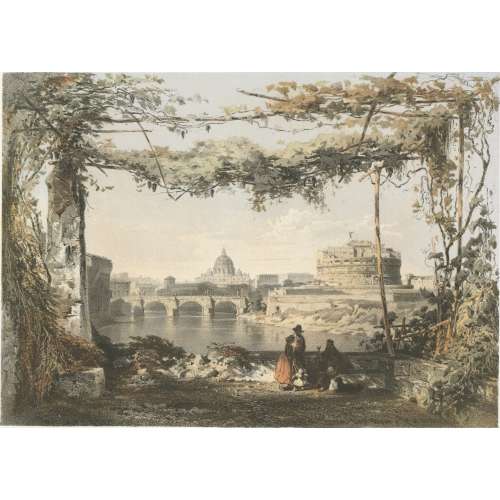
Sheet № 20 from the series of 42 сhromolithography prints 'Skizzen und Bilder aus ROM und der Umgegend' (Sketches and pictures from Rome and surroundings).
Inscriptions:
Top left: LINDEMANN-FROMMEL’S Top right: Skizzen und Bilder aus ROM und der Umgegend. Centre below: No 20 | IL CASTEL E IL PONTE SANT ANGELO, | E SAN PIETRO. Bottom left: Imp. de JACOMME et Cie. R. de Lancry, 16 Paris. Bottom centre: Stuttgart, bei FRANZ KÖHLER. Bottom right: Paris, Goupil et Cie. Editeurs.Dimensions:
Plate: 372 x 473 mm Sheet: 372 x 473 mm
Contributors:
Lindemann-Frommel, Karl (French-German, 1819 – 1891) – artist. Jacomme, Claude (French, fl. 1838 – 1857) – printer/lithographer. Goupil et Cie (Paris); Goupil, Adophe (French, 1806 – 1893) – publisher Franz Köhler (Stuttgart); Köhler, Franz (German, 1805 – 1872) – publisher. -
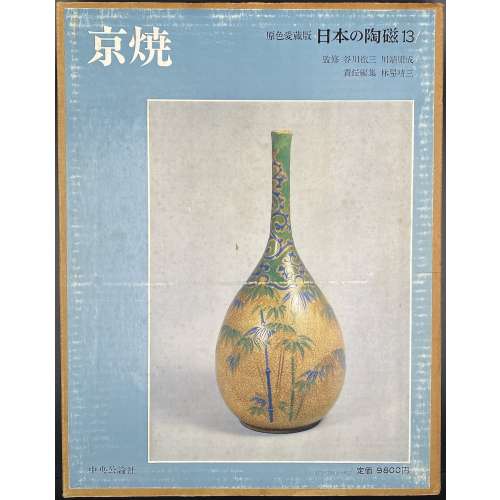 Hardcover volume, 35 x 27 cm, bound in grey cloth, blind stamped characters to front, brown characters to spine, in a glassine dust jacket, in a double slipcase, the outer case pictorial paper over cardboard, 36 x 28 cm, pp.: [4] [1] 2-124 (plates with photographs of 241 items), [2] 127-171 [3]. Kyō ware [京焼] (Kyō-yaki) – pottery from Kyoto. 日本の陶磁 – Japanese ceramics, series title. Contributors: Yasunari Kawabata [川端 康成] (Japanese, 1924 – 1972) – author. Tetsuzo Tanikawa [谷川 徹三] (Japanese, 1895 – 1989) – author. Seizo Hayashiya [林屋晴三] (Japanese, 1928 – 2017) – editor. Chūōkōron-sha [中央公論社] – publisher.
Hardcover volume, 35 x 27 cm, bound in grey cloth, blind stamped characters to front, brown characters to spine, in a glassine dust jacket, in a double slipcase, the outer case pictorial paper over cardboard, 36 x 28 cm, pp.: [4] [1] 2-124 (plates with photographs of 241 items), [2] 127-171 [3]. Kyō ware [京焼] (Kyō-yaki) – pottery from Kyoto. 日本の陶磁 – Japanese ceramics, series title. Contributors: Yasunari Kawabata [川端 康成] (Japanese, 1924 – 1972) – author. Tetsuzo Tanikawa [谷川 徹三] (Japanese, 1895 – 1989) – author. Seizo Hayashiya [林屋晴三] (Japanese, 1928 – 2017) – editor. Chūōkōron-sha [中央公論社] – publisher. -
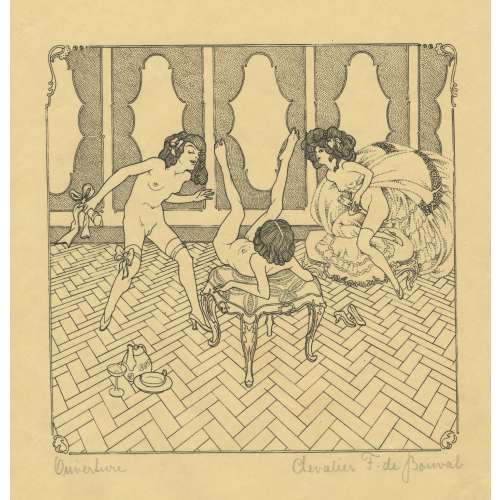 A set of sixteen planographic prints, signed and titled in pencil by owner “Chevalier F. de Bouval” (pseudonym of Franz von Bayros (Austrian, 1866 – 1924). Titles include: 1) Ouverture, 2) champagne brut, 3) maternité, 4) piano, 5) crudité délicieuse, 6. la belle vue, 7) au pensionnat, 8) le collier, 9) languelles pénètrelles, 10) introduction, 11) le sourrogat, 12) variation amoureuse, 13) la surprise, 14) le clef délicat, 15) le monstre gomme, 16) fruits de sud. Printed on wove paper, possibly engraved on wood after ink drawings by Franz von Bayros (Austrian, 1866 – 1924) under the pseudonym Chevalier F. de Bouval. Size: sheet 30 x 24 cm, image 18 x 17.5 cm. In another source, there are two more images from the same set: le passe-partout and la doublette, making 18 images altogether; the set is titled “Lesbia: XVIII sujets”, signed by Chevalier François René de Bouval.
A set of sixteen planographic prints, signed and titled in pencil by owner “Chevalier F. de Bouval” (pseudonym of Franz von Bayros (Austrian, 1866 – 1924). Titles include: 1) Ouverture, 2) champagne brut, 3) maternité, 4) piano, 5) crudité délicieuse, 6. la belle vue, 7) au pensionnat, 8) le collier, 9) languelles pénètrelles, 10) introduction, 11) le sourrogat, 12) variation amoureuse, 13) la surprise, 14) le clef délicat, 15) le monstre gomme, 16) fruits de sud. Printed on wove paper, possibly engraved on wood after ink drawings by Franz von Bayros (Austrian, 1866 – 1924) under the pseudonym Chevalier F. de Bouval. Size: sheet 30 x 24 cm, image 18 x 17.5 cm. In another source, there are two more images from the same set: le passe-partout and la doublette, making 18 images altogether; the set is titled “Lesbia: XVIII sujets”, signed by Chevalier François René de Bouval. -
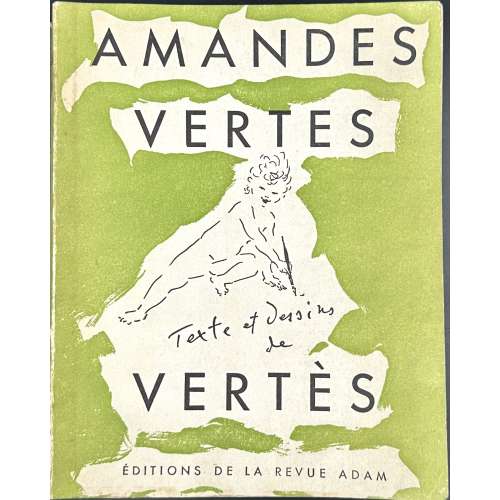 Paperback, 23.7 x 19 cm, green pictorial wrappers, lettering to spine, glassine dust jacket, some pages uncut, signed autograph blue ink inscription to h.t. "Au dr. Manuel Bruker en souvenir d'une harmonieuse collaboration. Vertès, 1952"; pp.[1-6] 7-489 [490] [2], profusely illustrated in b/w., Title-page: AMANDES VERTES | {vignette} | Texte et dessins | de | VERTÈS | ÉDITIONS REVUE ADAM | 4, RUE DE LA PAIX – PARIS – 2e || Limitation: Il a été tiré 200 exemplaires sur papier vélin d'arches; ceux-ci comportent un frontispice inédit en lithographie originale en 3 couleurs signée par l'auteur, tirée par Mourlot frères; ces exemplaires composent l'édition de luxe numérotée de 1 a 200. En plus, 20 exemplaires hors commence ont été réservés a des service personnels; ils sont numérotés de I a XX en chiffres romains. Ces deux éditions forment la totalité du tirage de luxe. Colophon: Achevé d'imprimer le 30 juin 1952 sur les presses de l'imprimerie Hérissey à Évreux numéro d'édition de l'éditeur : 91. Edition limited to 200 copies numbered 1 to 200 and 20 copies numbered from I to XX. This is copy № 91. No coloured frontispiece. Catalogue raisonné: Vokaer № 53. Provenance: Manuel Bruker (French, 1891 – 1979) Contributors: Marcel Vertès [Marcell Vértes] (Jewish-Hungarian-French, 1895 – 1961) – author/artist. Imprimerie Hérissey (Évreux) – printer. Edition Adam La Revue D' Homme [Revue Adam] – publisher.
Paperback, 23.7 x 19 cm, green pictorial wrappers, lettering to spine, glassine dust jacket, some pages uncut, signed autograph blue ink inscription to h.t. "Au dr. Manuel Bruker en souvenir d'une harmonieuse collaboration. Vertès, 1952"; pp.[1-6] 7-489 [490] [2], profusely illustrated in b/w., Title-page: AMANDES VERTES | {vignette} | Texte et dessins | de | VERTÈS | ÉDITIONS REVUE ADAM | 4, RUE DE LA PAIX – PARIS – 2e || Limitation: Il a été tiré 200 exemplaires sur papier vélin d'arches; ceux-ci comportent un frontispice inédit en lithographie originale en 3 couleurs signée par l'auteur, tirée par Mourlot frères; ces exemplaires composent l'édition de luxe numérotée de 1 a 200. En plus, 20 exemplaires hors commence ont été réservés a des service personnels; ils sont numérotés de I a XX en chiffres romains. Ces deux éditions forment la totalité du tirage de luxe. Colophon: Achevé d'imprimer le 30 juin 1952 sur les presses de l'imprimerie Hérissey à Évreux numéro d'édition de l'éditeur : 91. Edition limited to 200 copies numbered 1 to 200 and 20 copies numbered from I to XX. This is copy № 91. No coloured frontispiece. Catalogue raisonné: Vokaer № 53. Provenance: Manuel Bruker (French, 1891 – 1979) Contributors: Marcel Vertès [Marcell Vértes] (Jewish-Hungarian-French, 1895 – 1961) – author/artist. Imprimerie Hérissey (Évreux) – printer. Edition Adam La Revue D' Homme [Revue Adam] – publisher. -
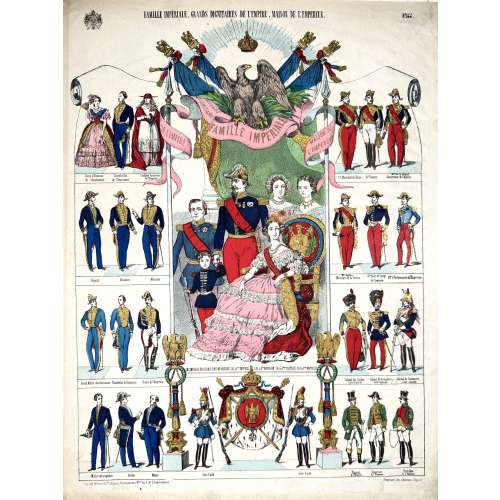 Hand-coloured woodcut on wove paper, 487 x 365 mm; black ink stamp “5056” to reverse. Top left: imperial coat of arms; centre: "FAMILLE IMPERIALE. GRANDS DIGNITAIRES DE L'EMPIRE, MAISON DE L'EMPEREUR."; right: "№144." Image of the imperial family under imperial eagle and standards; besides – four tiers of captioned cartoons. Bottom left: "Imprimerie Lith. de Pellerin, à Épinal"; right: "Propriété de l’Éditeur. — Déposé." Jean Charles Pellerin (French, 1756 – 1836) – printer/publisher.
Hand-coloured woodcut on wove paper, 487 x 365 mm; black ink stamp “5056” to reverse. Top left: imperial coat of arms; centre: "FAMILLE IMPERIALE. GRANDS DIGNITAIRES DE L'EMPIRE, MAISON DE L'EMPEREUR."; right: "№144." Image of the imperial family under imperial eagle and standards; besides – four tiers of captioned cartoons. Bottom left: "Imprimerie Lith. de Pellerin, à Épinal"; right: "Propriété de l’Éditeur. — Déposé." Jean Charles Pellerin (French, 1756 – 1836) – printer/publisher. -
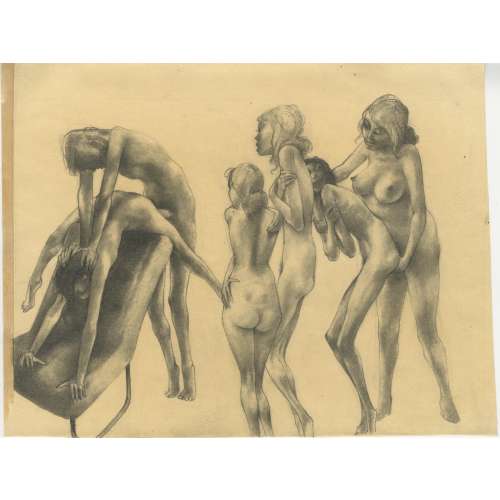 Graphite on wove paper, 217 x 284 mm, black ink stamp to verso: “Prof O. R. Schatz | Wien II, Gr. Mohreng 3b | Tel.: 55 82 566”. Unsigned, attributed to Otto Rudolf Schatz (Austrian, 1900 – 1961).
Graphite on wove paper, 217 x 284 mm, black ink stamp to verso: “Prof O. R. Schatz | Wien II, Gr. Mohreng 3b | Tel.: 55 82 566”. Unsigned, attributed to Otto Rudolf Schatz (Austrian, 1900 – 1961). -

Исэ-Моногатари. Лирическая повесть древней Японии. Перевод и предисловие Н. Конрад. Гос. изд-во "Всемирная литература", 1923.
Перевод на русский язык (с японского издания 1912 года) был выполнен выдающимся советским востоковедом Н И. Конрадом и опубликован в 1923 году издательством «Всемирная литература». Неполностью разрезана, залита по краям, надрывы обложки.
-
 Artist: Utagawa Kunisada [歌川 国貞], a.k.a. Utagawa Toyokuni III [三代 歌川 豊国] (Japanese, 1786 – 1865). Signed: Toyokuni ga [豊国 画] in a red toshidama cartouche Block carver: Yokokawa Takejirō [横川竹二郎] (Japanese, fl. 1845 – 1863), seal: 彫竹 – hori Take. Publisher: Ibaya Senzaburō [伊場屋仙三郎] (Japanese, fl. c. 1845 – 1847). Media: Untrimmed fan print (uchiwa-e), 230 x 295 mm. Combined date seal and kiwame censor seal: Ansei 6 (1859). Title: Princess Sotoori [衣通姫] (Sotoori-hime) – Sotoori-hime was a concubine of Emperor Ingyo (reigned AD 412-53), and one of the Three Gods of Japanese Poetry [和歌三神] (Waka sanjin). Series: Chronicles of Elegant Women [風雅女史傳] (Fūga joshiden). The sign on the torii (Shinto shrine gates) reads: Mountain king shrine [山王宮] – it is the Sannō Shrine at the Nagata Riding Grounds in Edo. A print with these gates is at MFA (Boston) # 21.9853.
Artist: Utagawa Kunisada [歌川 国貞], a.k.a. Utagawa Toyokuni III [三代 歌川 豊国] (Japanese, 1786 – 1865). Signed: Toyokuni ga [豊国 画] in a red toshidama cartouche Block carver: Yokokawa Takejirō [横川竹二郎] (Japanese, fl. 1845 – 1863), seal: 彫竹 – hori Take. Publisher: Ibaya Senzaburō [伊場屋仙三郎] (Japanese, fl. c. 1845 – 1847). Media: Untrimmed fan print (uchiwa-e), 230 x 295 mm. Combined date seal and kiwame censor seal: Ansei 6 (1859). Title: Princess Sotoori [衣通姫] (Sotoori-hime) – Sotoori-hime was a concubine of Emperor Ingyo (reigned AD 412-53), and one of the Three Gods of Japanese Poetry [和歌三神] (Waka sanjin). Series: Chronicles of Elegant Women [風雅女史傳] (Fūga joshiden). The sign on the torii (Shinto shrine gates) reads: Mountain king shrine [山王宮] – it is the Sannō Shrine at the Nagata Riding Grounds in Edo. A print with these gates is at MFA (Boston) # 21.9853. Other prints from the same series in this collection:
SVJP-0343.2021 — Tamagiku:
Other prints from the same series in this collection:
SVJP-0343.2021 — Tamagiku:
 SVJP-0400.2023 — Saiko:
SVJP-0400.2023 — Saiko:
 Note: Special thanks to Horst Graebner, who helped decipher and understand the meaning.
Note: Special thanks to Horst Graebner, who helped decipher and understand the meaning.
-
 Artist: Utagawa Toyokuni I [歌川豊国] (1769–1825). Title: 「しなのやおこん 瀬川菊之丞」「帯屋長右衛門 嵐雛助」 Kabuki play: Katsuragawa Renri no Shigarami [桂川連理柵]. According to Waseda University Cultural Resource Database, the play was performed at Ichimura-za (Edo) on the 2nd month of Kansei 12 (year 1800) under the title 楼門五山桐 さんもんごさんのきり. Publisher: Nishimuraya Yohachi [西村屋与八] (Japanese, c. 1751 – 1869)., Play by Suga Sensuke [菅専助] (ca. 1728 – 1791) in two acts. First performed at Kita Horie-za in Osaka in October 1776. Based on a real incident occurring sometime in the Kyōhō era (1716-35), this story was first dramatized in 1761. The first Kabuki drama to stem from this play was in 1777 at Osaka's Araki-za. Obiya Chōemon, a married obi merchant (sitting with abacus) in his forties, meets his neighbour's daughter Ohan (standing behind Obiya), who is young enough to be his daughter, at an inn in Ishibe; the two fall in love and pledged their troth. Ohan becomes pregnant. After a series of misfortunes, the lovers rush to Katsuragawa (Katsura River), where they drown themselves.
Artist: Utagawa Toyokuni I [歌川豊国] (1769–1825). Title: 「しなのやおこん 瀬川菊之丞」「帯屋長右衛門 嵐雛助」 Kabuki play: Katsuragawa Renri no Shigarami [桂川連理柵]. According to Waseda University Cultural Resource Database, the play was performed at Ichimura-za (Edo) on the 2nd month of Kansei 12 (year 1800) under the title 楼門五山桐 さんもんごさんのきり. Publisher: Nishimuraya Yohachi [西村屋与八] (Japanese, c. 1751 – 1869)., Play by Suga Sensuke [菅専助] (ca. 1728 – 1791) in two acts. First performed at Kita Horie-za in Osaka in October 1776. Based on a real incident occurring sometime in the Kyōhō era (1716-35), this story was first dramatized in 1761. The first Kabuki drama to stem from this play was in 1777 at Osaka's Araki-za. Obiya Chōemon, a married obi merchant (sitting with abacus) in his forties, meets his neighbour's daughter Ohan (standing behind Obiya), who is young enough to be his daughter, at an inn in Ishibe; the two fall in love and pledged their troth. Ohan becomes pregnant. After a series of misfortunes, the lovers rush to Katsuragawa (Katsura River), where they drown themselves.Segawa Kikunojō III (Japanese, 1751 – 1810); other names: Segawa Senjo, Segawa Rokō III, Segawa Tomisaburō I, Ichiyama Tomisaburō, Ichiyama Shichinosuke. The actor held the name of Segawa Kikunojō III from the 11th lunar month of 1774 to the 7th lunar month of 1801. He surpassed all the actors of his time in both female and male roles, especially in the former, and achieved tremendous public acclaim.
Arashi Hinasuke II [嵐雛助] (Japanese, c. 1774 – 1801); other names: Nakamura Jūzō III, Kanō Hidenosuke I, Arashi Hidenosuke I. The actor held the name of Arashi Hinasuke II from the 1st lunar month of 1794 to the 2nd lunar month of 1801. Hi died in Edo on the 4th day of the 2nd lunar month of 1801. For the same characters illustrated by Utagawa Kuniyoshi see SVJP-0333.2021. Sources:
Sources:
- Historical Dictionary of Japanese Traditional Theatre By Samuel L. Leiter. Second edition, 2014.
- Kabuki Encyclopedia. An English-Langauge Adaptation of Kabuki Jiten. Samuel L. Leiter. Greenwood Press, 1979.
- http://www.kabuki21.com/
- Waseda University Cultural Resource Database
-
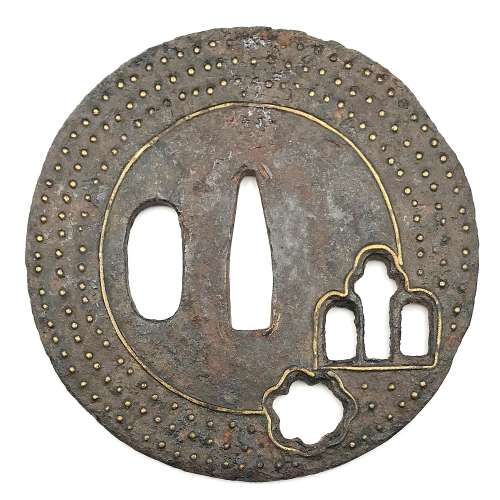 Iron tsuba of round form with design of iris and snowflake in openwork (ko-sukashi or small cut-outs) outlined with brass wire. Three concentric rows of brass dots (ten-zōgan), with a brass circular line inside the innermost row of dots (missing on the back). Hitsu-ana is not outlined with brass wire, which let us suppose that it was cut out at a later date. Iron and brass. Ko-sukashi and ten-zōgan technique. Mid Muromachi period (1454-1513). Height: 74.0 mm, Width: 73.6 mm, Thickness: 3.0 mm.
Iron tsuba of round form with design of iris and snowflake in openwork (ko-sukashi or small cut-outs) outlined with brass wire. Three concentric rows of brass dots (ten-zōgan), with a brass circular line inside the innermost row of dots (missing on the back). Hitsu-ana is not outlined with brass wire, which let us suppose that it was cut out at a later date. Iron and brass. Ko-sukashi and ten-zōgan technique. Mid Muromachi period (1454-1513). Height: 74.0 mm, Width: 73.6 mm, Thickness: 3.0 mm.NBTHK certification of 1968: "Kicho". Condition is relatively poor: rust, missing inlay, scratches.
While representation of the snowflake is rather standard, the meaning of the other cut-out design was initially less clear. Similar symbol was found at (1) "Kokusai Tosogu Kai, International Convention & Exhibition, September 24-25, 2005, The Frazier Historical Arms Museum, Louisville, Kentucky, USA"; on page 21 there is a photograph J-6 of a ko-tosho tsuba with "iris theme openwork"; (2) Japanese Swords and Tsuba from the Professor A. Z. Freeman and the Phyllis Sharpe Memorial collections. Sotheby's, London, Thursday 10 April 1997; page 11, lot 6 - a ko-katchushi tsuba of early Muromachi period fith "simple design of stylized iris". In both sources the symbol is explained as 'iris" (kakitsubata).
Freeman and Sharpe collections. Sotheby's, 1997.

Kokusai Tosogu Kai, September 24-25, 2005.
-
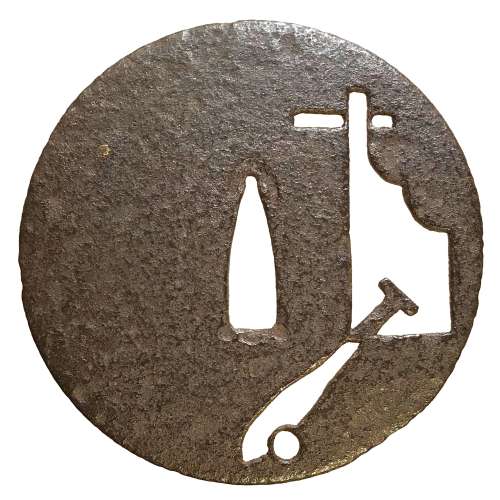 Round tsuba of iron; well forged thin plate decorated with a rudder (kaji) and an oar, or paddle (kai) with a water drop, executed in a combination of negative (in-sukashi) and positive (ji-sukashi) openwork. It may be Ko-Tōshō (old Tōshō) or just Tōshō school, without a 'Ko'. The characteristics of the plate point toward an older piece, however the combination of negative and positive silhouettes pulls the date of manufacture in an opposite direction. Muromachi period. Height: 90.0 mm. Width: 89.0 mm. Rim thickness: 2.1 mm. Center thickness: 2.3 mm. Nakago-ana: height = 29 mm, width = 8.8 mm. A rudder and an oar design is classified by John W. Dower as "Sailing vessels and gear": "Unlike many other motifs, sailing vessels and sailing gear failed to collect an interesting lore or to develop levels of meaning." Merrily Baird does not say anything about these symbols. Yuzuri Okada says: "Ships, sails, rudders, etc. also supply motive of the same class as wheels." He does not provide us with the description of the motive supplied by the wheel. The same motif is used on Ōnin tsuba in this collection:
Round tsuba of iron; well forged thin plate decorated with a rudder (kaji) and an oar, or paddle (kai) with a water drop, executed in a combination of negative (in-sukashi) and positive (ji-sukashi) openwork. It may be Ko-Tōshō (old Tōshō) or just Tōshō school, without a 'Ko'. The characteristics of the plate point toward an older piece, however the combination of negative and positive silhouettes pulls the date of manufacture in an opposite direction. Muromachi period. Height: 90.0 mm. Width: 89.0 mm. Rim thickness: 2.1 mm. Center thickness: 2.3 mm. Nakago-ana: height = 29 mm, width = 8.8 mm. A rudder and an oar design is classified by John W. Dower as "Sailing vessels and gear": "Unlike many other motifs, sailing vessels and sailing gear failed to collect an interesting lore or to develop levels of meaning." Merrily Baird does not say anything about these symbols. Yuzuri Okada says: "Ships, sails, rudders, etc. also supply motive of the same class as wheels." He does not provide us with the description of the motive supplied by the wheel. The same motif is used on Ōnin tsuba in this collection: